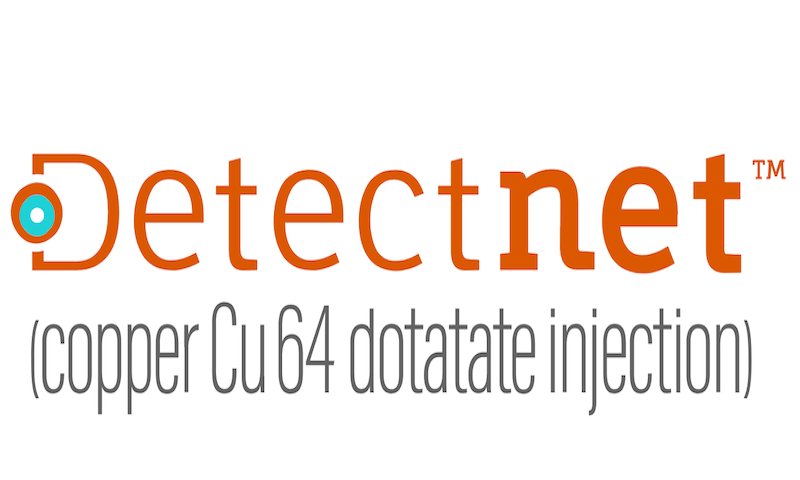
8th septiembre 2020
RadioMedix and Curium Announce FDA Approval of Detectnet (copper Cu 64 dotatate injection) in the U.S.
———
Download as PDF: English
———
(Houston, TX and St. Louis, MO – September 8 2020) – RadioMedix Inc. and its commercial partner Curium announced today that Detectnet™ (copper Cu 64 dotatate injection) was approved by the U.S. Food and Drug Administration (FDA). Detectnet is a positron emission tomography (PET) agent indicated for the localization of somatostatin receptor positive neuroendocrine tumors (NETs) in adult patients. Curium expects to launch Detectnet immediately with doses available through various nuclear pharmacies or directly from Curium.
“Detectnet brings an exciting advancement in the diagnosis of neuroendocrine tumors for healthcare providers, patients, and their caregivers,” said Ebrahim Delpassand, MD, CEO of RadioMedix. “The Phase III results demonstrate the clinical sensitivity and specificity of Detectnet which will provide a great aid to clinicians in developing an accurate treatment approach for their NET patients. Perhaps most exciting is that the 12.7-hour half-life allows Detectnet to be produced centrally and shipped to sites throughout the U.S. This will help alleviate shortages or delays that have been experienced with other somatostatin analogue PET agents.”
“Curium is excited to bring the first commercially available Cu 64 diagnostic agent to the U.S. market. Our unique production capabilities and distribution network allow us to deliver to any nuclear pharmacy, hospital or imaging center its full dosing requirements first thing in the morning, to provide scheduling flexibility to the institution and its patients,” said Curium CEO, North America, Dan Brague. “We look forward to joining with healthcare providers and our nuclear pharmacy partners to bring this highly efficacious agent to the market.”
About Detectnet
IMPORTANT RISK INFORMATION
WARNINGS AND PRECAUTIONS
Radiation Risk
Diagnostic radiopharmaceuticals, including Detectnet, contribute to a patient’s overall long-term cumulative radiation exposure. Long-term cumulative radiation exposure is associated with an increased risk of cancer. Ensure safe handling and preparation procedures to protect patients and health care workers from unintentional radiation exposure. Advise patients to hydrate before and after administration and to void frequently after administration.
Risk for Image Misinterpretation
The uptake of copper Cu 64 dotatate reflects the level of somatostatin receptor density in NETs, however, uptake can also be seen in a variety of other tumors that also express somatostatin receptors. Increased uptake might also be seen in other non-cancerous pathologic conditions that express somatostatin receptors including thyroid disease or in subacute inflammation, or might occur as a normal physiologic variant (e.g. uncinate process of the pancreas).
A negative scan after the administration of Detectnet in patients who do not have a history of NET disease does not rule out disease.
ADVERSE REACTIONS
In clinical trials, adverse reactions occurred at a rate of < 2% and included nausea, vomiting and flushing. In published trials nausea immediately after injection was observed.
DRUG INTERACTIONS
Somatostatin Analogs
Non-radioactive somatostatin analogs and copper Cu 64 dotatate competitively bind to somatostatin receptors (SSTR2). Image patients just prior to dosing with somatostatin analogs. For patients on long-acting somatostatin analogs, a wash-out period of 28 days is recommended prior to imaging. For patients on short-acting somatostatin analogs, a washout period of 2 days is recommended prior to imaging.
USE IN SPECIFIC POPULATIONS
Pregnancy
All radiopharmaceuticals, including Detectnet, have the potential to cause fetal harm depending on the fetal stage of development and the magnitude of the radiation dose. Advise a pregnant woman of the potential risks of fetal exposure to radiation from administration of Detectnet.
Lactation
Advise a lactating woman to interrupt breastfeeding for 12 hours after Detectnet administration in order to minimize radiation exposure to a breastfed infant.
Pediatric use
The safety and effectiveness of Detectnet have not been established in pediatric patients.
Geriatric use
In general, dose selection for an elderly patient should be cautious, usually starting at the low end of the dosing range, reflecting the greater frequency of decreased hepatic, renal, or cardiac function, and of concomitant disease or other drug therapy.
OVERDOSAGE
In the event of a radiation overdose, the absorbed dose to the patient should be reduced where possible by increasing the elimination of the radionuclide from the body by reinforced hydration and frequent bladder voiding. A diuretic might also be considered.
Please see full Prescribing Information by clicking here or visit www.curiumpharma.com/product/detectnet
About RadioMedix
RadioMedix, Inc. is a clinical stage biotechnology company, based in Houston, Texas, focused on innovative targeted radiopharmaceuticals for diagnosis, monitoring, and therapy of cancer. The company is commercializing radiopharmaceuticals for PET imaging and therapeutic (alpha and beta-labeled) radiopharmaceuticals. RadioMedix has also established contract service facilities for academic and industrial partners: Full cGMP manufacturing and analytical suites for human clinical trials, and commercial phase manufacturing of the radiopharmaceuticals, and probe development and small animal Molecular Imaging Facility for pre-clinical evaluation of radiopharmaceuticals in animal models. To learn more, visit www.radiomedix.com. For more information about this press release, please contact: media@radiomedix.com
About Curium
Curium is the world’s largest nuclear medicine company. We develop, manufacture and distribute world-class radiopharmaceutical products to help patients around the globe. Our proven heritage combined with a pioneering approach are the hallmarks to deliver innovation, excellence and unparalleled service.
With manufacturing facilities across Europe and the United States, Curium delivers SPECT, PET and therapeutic radiopharmaceutical solutions for life-threatening diseases to over 14 million patients annually. The name ‘Curium’ honors the legacy of pioneering radioactive researchers Marie and Pierre Curie, after whom the radioactive element curium was named and emphasizes our focus on nuclear medicine. To learn more, visit www.curiumpharma.com For more information about this press release, please contact Janet Ryan, media contact for Curium: janet@ryan-pr.com.
About Neuroendocrine Tumors
Neuroendocrine tumors (NETs) are a heterogeneous group of rare neoplasms that originate from neuroendocrine cells. These neoplasms occur mostly in the gastrointestinal tract, pancreas and liver, but can also occur in other tissues including lung, thymus and other uncommon sites such as cervix, heart and prostate. Most NETs strongly express somatostatin receptors (SSTRs).